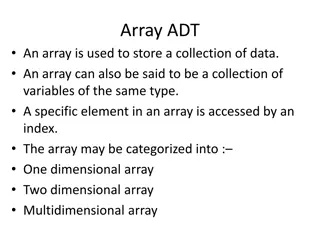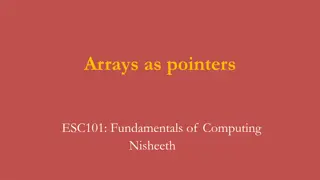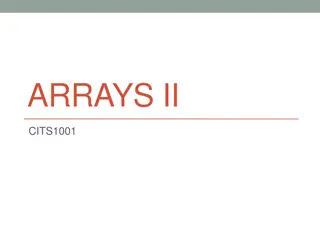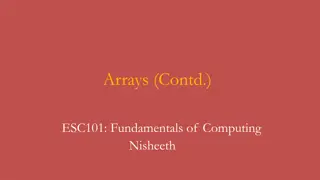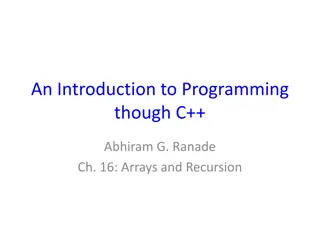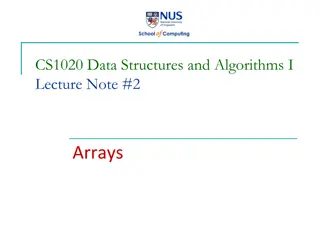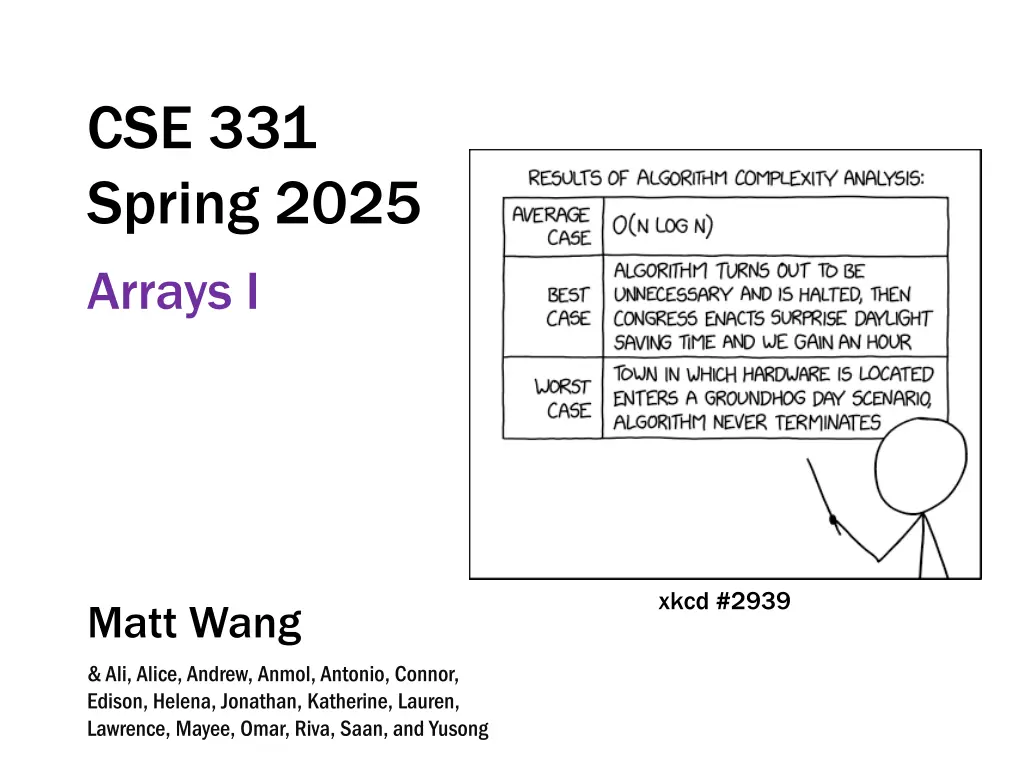
Efficient Array Implementation and List Indexing Techniques
In this study of array and list data structures, explore efficient array implementation for faster indexing and the importance of following "next" pointers in linked lists. Learn about the benefits and drawbacks of array and linked list structures, along with the considerations for accessing elements by index in both structures. Discover insights on memory efficiency and optimal operations in data structure handling.
Download Presentation

Please find below an Image/Link to download the presentation.
The content on the website is provided AS IS for your information and personal use only. It may not be sold, licensed, or shared on other websites without obtaining consent from the author. If you encounter any issues during the download, it is possible that the publisher has removed the file from their server.
You are allowed to download the files provided on this website for personal or commercial use, subject to the condition that they are used lawfully. All files are the property of their respective owners.
The content on the website is provided AS IS for your information and personal use only. It may not be sold, licensed, or shared on other websites without obtaining consent from the author.
E N D
Presentation Transcript
CSE 331 Spring 2025 Arrays I xkcd #2939 Matt Wang & Ali, Alice, Andrew, Anmol, Antonio, Connor, Edison, Helena, Jonathan, Katherine, Lauren, Lawrence, Mayee, Omar, Riva, Saan, and Yusong
Administrivia (05/23) HW8 is out! beware: coding portion has a good chunk of math! but also: very fun app :) Holiday on Monday no class no class no office hours no office hours some (reduced) Ed activity some (reduced) Ed activity Implication: please start HW8 early!! Implication: please start HW8 early!! next Fri: a bit on the final exam next Fri: a bit on the final exam 2
List Indexing at : (List, ) at(nil , n) at(x :: L , 0) at(x :: L , n+1) := undefined := x := at(L, n) Retrieve an element of the list by index use "L[j]" as an abbreviation for at(j, L) Not an efficient operation on lists 3
Linked Lists in Memory 1 5 4 L 3 2 Must follow the "next" pointers to find elements at(L, n) is an O(n) operation no faster way to do this 4
Faster Implementation of at 1 2 3 4 5 L L[4] Alternative: store the elements next to each other can find the n-th entry by arithmetic: location of L[4] = (location of L) + 4 * sizeof(data) Resulting data structure is an array consider: arrays can be an implementation of the List ADT array 5
Array Efficiency 1 2 3 4 5 L L[4] Resulting data structure is an array array Efficient to read L[i] Inefficient to insert elements anywhere but the end write operations with an immutable ADT trees can do all of this in O(log n) time 6
Access By Index Easily access both L[0] and L[n-1], where n = len(L) can process a list in either direction With great power, comes great responsibility the Peter Parker Principle Whenever we write A[j] , we must check 0 j < n new bug just dropped! with list, we only need to worry about nil and non-nil once we know L is non-nil, we know L.hd exists TypeScript will not help us with this! type checker does catch could be nil bugs, but not this 7
Recall: Sum List With a Loop sum-acc(nil, r) sum-acc(x :: L, r) := sum-acc(L, x + r) := r Tail recursive version is a loop const sum = (S: List<bigint>): bigint => { let r = 0; // Inv: sum(S0) = r + sum(S) while (S.kind !== "nil") { r = S.hd + r; S = S.tl; } return r; }; Change to a version that uses indexes 8
Sum Array by Index Change to using an array and accessing by index const sum = (S: Array<bigint>): bigint => { let r = 0; let j = 0; // Inv: while (j !== S.length) { // S.kind !== "nil" r = S[j] + r; // r = S.hd + r j = j + 1; // S = S.tl } return r; }; Note that S is no longer changing 9
Sum Array by Index: compared to sum-acc sum-acc : (List, , ) sum-acc(S, j, r) sum-acc(S, j, r) Change to using an array and accessing by index if j = len(S) if j len(S) := r := sum-acc(S, j+1, S[j] + r) const sum = (S: Array<bigint>): bigint => { let r = 0; let j = 0; // Inv: while (j !== S.length) { r = S[j] + r; j = j + 1; } return r; }; 10
Sublists Use indexes to refer to a section of a list (a "sublist"): sublist : (List< >, , ) List< > if j < i sublist(L, i, j) sublist(L, i, j) := nil := L[i] :: sublist(L, i + 1, j) if i j Useful for reasoning about lists and indexes This includes both L[i] and L[j] def of sublist (since 0 2) def of sublist (since 1 2) def of sublist (since 2 2) def of sublist (since 3 < 2) sublist(L, 0, 2) = L[0] :: sublist(L, 1, 2) = L[0] :: L[1] :: sublist(L, 2, 2) = L[0] :: L[1] :: L[2] :: sublist(L, 3, 2) = L[0] :: L[1] :: L[2] :: nil = [L[0], L[1], L[2]] 11
Sublists and Edge Cases Use indexes to refer to a section of a list (a "sublist"): sublist : (List< >, , ) List< > if j < i sublist(L, i, j) sublist(L, i, j) := nil := L[i] :: sublist(L, i + 1, j) if i j The sublist is empty when the range range is empty sublist(L, 3, 2) = nil weird-looking example that comes up a lot: sublist(L, 0, -1) = nil not an array out of bonds error! (this is math, not Java) 12
Sublist Shorthands and Facts sublist : (List< >, , ) List< > if j < i sublist(L, i, j) sublist(L, i, j) := nil := L[i] :: sublist(L, i + 1, j) if i j Will use "L[i .. j]" as shorthand for "sublist(L, i, j)" again, using an operator for most common operations Some useful facts about sublists: L = L[0 .. len(L)-1] for any k with i 1 k j (and 0 i j < n) L[i .. j] = L[i .. k] L[k+1 .. j] 13
Sum Array by Index: sum-acc, in math if j = len(S) if j len(S) sum-acc(S, j, r) sum-acc(S, j, r) := r := sum-acc(S, j+1, S[j] + r) Change to using an array and accessing by index const sum = (S: Array<bigint>): bigint => { let r = 0; let j = 0; // Inv: ?? while (j != S.length) { r = S[j] + r; j = j + 1; } return r; }; Still need to fill in Inv Need a version using indexes. 14
Recall: Sum List With a Loop, with Invariant Tail recursive version is a loop const sum = (S: List<bigint>): bigint => { let r = 0; // Inv: sum(S0) = r + sum(S) while (S.kind !== "nil") { r = S.hd + r; S = S.tl; } return r; }; Inv says sum(S0) is r plus sum of rest (S) Not the most explicit way of explaining "r" 15
Visual Intuition for Sum List Loop Invariant S0 S sum(S0) = r + sum(S) "r" contains sum of the part of the list seen so far Can explain this more simply with indexes no longer need to move S 16
Visual Intuition for Index & Sublist Loop Invariant j S sum(S) = r + sum(S[j .. n-1]) Sum is the part in "r" plus the part left in S[j .. n-1] What sum is in "r"? r = sum(S[0 .. j-1]) we can use just this as our invariant! (it's all we need) 17
Sum of an Array: Loop Invariant Array version uses access by index const sum = (S: Array<bigint>): bigint => { let r = 0; let j = 0; // Inv: r = sum(S[0 .. j-1]) while (j != S.length) { r = S[j] + r; j = j + 1; } return r; }; Are we sure this is right? Let's think it through 18
Sum of an Array Floyd Logic: Initialization const sum = (S: Array<bigint>): bigint => { let r = 0; let j = 0; {{ r = 0 and j = 0 }} {{ r = 0 and j = 0 }} {{ {{ Inv: : r = sum(S[0 .. j r = sum(S[0 .. j- -1]) }} 1]) }} while (j != S.length) { r = S[j] + r; j = j + 1; } return r; }; Does Inv hold initially? sum(S[0 .. j-1]) = sum(S[0 .. -1]) = sum([]) = 0 = r since j = 0 def of sum 19
Sum of an Array Floyd Logic: Postcondition const sum = (S: Array<bigint>): bigint => { let r = 0; let j = 0; {{ Inv Inv: r = sum(S[0 .. j-1]) }} while (j != S.length) { r = S[j] + r; j = j + 1; } {{ r = sum(S[0 .. j {{ r = sum(S[0 .. j- -1]) and j = 1]) and j = len {{ r = sum(S) }} {{ r = sum(S) }} return r; }; r = sum(S[0 .. j-1]) = sum(S[0 .. len(S)-1]) = sum(S) len(S) }} (S) }} Does the postcondition hold? since j = len(S) 20
Sum of an Array Floyd Logic: Loop Body (1/4) const sum = (S: Array<bigint>): bigint => { let r = 0; let j = 0; {{ Inv Inv: r = sum(S[0 .. j-1]) }} while (j != S.length) { {{ r = sum(S[0 .. j {{ r = sum(S[0 .. j- -1]) and j 1]) and j len r = S[j] + r; j = j + 1; {{ r = sum(S[0 .. j {{ r = sum(S[0 .. j- -1]) }} 1]) }} } return r; }; len(S) }} (S) }} 21
Sum of an Array Floyd Logic: Loop Body (2/4) const sum = (S: Array<bigint>): bigint => { let r = 0; let j = 0; {{ Inv Inv: r = sum(S[0 .. j-1]) }} while (j != S.length) { {{ r = sum(S[0 .. j {{ r = sum(S[0 .. j- -1]) and j 1]) and j len r = S[j] + r; {{ r = sum(S[0 .. j]) }} {{ r = sum(S[0 .. j]) }} j = j + 1; {{ r = sum(S[0 .. j {{ r = sum(S[0 .. j- -1]) }} 1]) }} } return r; }; len(S) }} (S) }} 22
Sum of an Array Floyd Logic: Loop Body (3/4) const sum = (S: Array<bigint>): bigint => { let r = 0; let j = 0; {{ Inv Inv: r = sum(S[0 .. j-1]) }} while (j != S.length) { {{ r = sum(S[0 .. j {{ r = sum(S[0 .. j- -1]) and j 1]) and j len {{ S[j] + r = sum(S[0 .. j]) }} {{ S[j] + r = sum(S[0 .. j]) }} r = S[j] + r; {{ r = sum(S[0 .. j]) }} {{ r = sum(S[0 .. j]) }} j = j + 1; {{ r = sum(S[0 .. j {{ r = sum(S[0 .. j- -1]) }} 1]) }} } return r; }; len(S) }} (S) }} 23
Sum of an Array Floyd Logic: Loop Body (4/4) const sum = (S: Array<bigint>): bigint => { let r = 0; let j = 0; {{ Inv Inv: r = sum(S[0 .. j-1]) }} while (j != S.length) { {{ r = sum(S[0 .. j {{ r = sum(S[0 .. j- -1]) and j 1]) and j len {{ S[j] + r = sum(S[0 .. j]) }} {{ S[j] + r = sum(S[0 .. j]) }} r = S[j] + r; {{ r = sum(S[0 .. j]) }} {{ r = sum(S[0 .. j]) }} j = j + 1; {{ r = sum(S[0 .. j {{ r = sum(S[0 .. j- -1]) }} 1]) }} } return r; }; len(S) }} (S) }} Is this valid? 24
Proving Loop Body Preservation (1/3) {{ r = sum(S[0 .. j {{ r = sum(S[0 .. j- -1]) and j {{ S[j] + r = sum(S[0 .. j]) }} {{ S[j] + r = sum(S[0 .. j]) }} 1]) and j len len(S) }} (S) }} S[j] + r = S[j] + sum(S[0 .. j-1]) = sum(S[0 .. j-1]) + S[j] = sum(S[0 .. j-1]) + sum([S[j]]) = sum(S[0 .. j-1]) + sum(S[j .. j]) = = sum(S[0 .. j]) since r = sum(S[0 .. j-1]) def of sum 25
Proving Loop Body Preservation (2/3) {{ r = sum(S[0 .. j {{ r = sum(S[0 .. j- -1]) and j {{ S[j] + r = sum(S[0 .. j]) }} {{ S[j] + r = sum(S[0 .. j]) }} 1]) and j len len(S) }} (S) }} S[j] + r = S[j] + sum(S[0 .. j-1]) = sum(S[0 .. j-1]) + S[j] = sum(S[0 .. j-1]) + sum([S[j]]) = sum(S[0 .. j-1]) + sum(S[j .. j]) = = sum(S[0 .. j-1] S[j .. j]) = sum(S[0 .. j]) since r = sum(S[0 .. j-1]) def of sum We saw that len(L R) = len(L) + len(R) Does sum(L R) = sum(L) + sum(R)? Yes! Very similar proof by structural induction. (Call this Lemma 3) 26
Proving Loop Body Preservation (3/3) {{ r = sum(S[0 .. j {{ r = sum(S[0 .. j- -1]) and j {{ S[j] + r = sum(S[0 .. j]) }} {{ S[j] + r = sum(S[0 .. j]) }} 1]) and j len len(S) }} (S) }} S[j] + r = S[j] + sum(S[0 .. j-1]) = sum(S[0 .. j-1]) + S[j] = sum(S[0 .. j-1]) + sum([S[j]]) = sum(S[0 .. j-1]) + sum(S[j .. j]) = sum(S[0 .. j-1] S[j .. j]) = sum(S[0 .. j]) since r = sum(S[0 .. j-1]) def of sum by Lemma 3 (The need to reason by induction comes up all the time.) 27
Linear Search of a List contains(nil, y) contains(x :: L, y) := true contains(x :: L, y) := contains(L, y) if x y := false if x = y Tail-recursive definition const contains = (S: List<bigint>, y: bigint): bigint => { // Inv: contains(S0, y) = contains(S, y) while (S.kind !== "nil" && S.hd !== y) { S = S.tl; } return S.kind !== "nil"; // implies S.hd === y }; Change to a version that uses indexes 35
Linear Search of an Array contains(nil, y) contains(x :: L, y) := true contains(x :: L, y) := contains(L, y) if x y := false if x = y Change to using an array and accessing by index const contains = (S: Array<bigint>, y: bigint): bigint => { let j = 0; // Inv: while (j !== S.length && S[j] !== y) { j = j + 1; } return j !== S.length; }; S.hd with S changing becomes S[j] with j changing What is the invariant now? 36
Linear Search of an Array: Loop Invariant contains(nil, y) contains(x :: L, y) := true contains(x :: L, y) := contains(L, y) if x y := false if x = y Change to using an array and accessing by index const contains = (S: Array<bigint>, y: bigint): bigint => { let j = 0; // Inv: contains(S, y) = contains(S[j .. n-1], y) while (j !== S.length && S[j] !== y) { j = j + 1; } return j !== S.length; }; Can we explain this better? 37
Linear Search of an Array: Visual Intuition S j contains(S, y) = contains(S[j .. n-1], y) What do we know about the left segment? it does not contain "y" that's why we kept searching S __ y j 38
Linear Search of an Array: Refined Invariant S __ y j Update the invariant to be more informative const contains = (S: Array<bigint>, y: bigint): bigint => { let j = 0; // Inv: S[i] y for any i = 0 .. j-1 while (j !== S.length && S[j] !== y) { j = j + 1; } return j !== S.length; }; 39
Sublist For any Facts With great power, comes great responsibility Since we can easily access any L[j], may need to keep track of facts about it may need facts about every element in the list applies to preconditions, postconditions, and intermediate assertions We can write facts about several elements at once: this says that elements at indexes 0 .. j-1 are not y for any 0 i < j S[i] y shorthand for j facts: S[0] y, , S[j-1] y 40
Reasoning Toolkit Description Testing Tools Reasoning no mutation full coverage type checker calculation induction local variable mutation Floyd logic heap state rep invariants arrays for-any facts 41
Sublist For any Facts & Pictures With great power, comes great responsibility since we can easily access any L[j], may need facts about it We can write facts about several elements at once: this says that elements at indexes 0 .. j-1 are not y for any 0 i < j S[i] y These facts get hard to write down! we will need to find ways to make this easier a common trick is to draw pictures instead 42
Visual Presentation of Facts S __ y j Just saw this example But we have seen "for any" facts with BSTs x contains-key(y, L) (y < x) contains-key(z, R) (x < z) L R "for any" facts are common in more complex code drawing pictures is a typical coping mechanism 43
Proving Linear Search of an Array: Initialization S __ y j const contains = (S: Array<bigint>, y: bigint): boolean => { let j = 0; {{ j = 0 }} {{ Inv: S[i] y for any 0 i j 1 }} while (j !== S.length && S[j] !== y) { j = j + 1; } return j !== S.length; }; What is the picture when j = 0? Inv holds because no i is in [0, -1] ( vacuously true ) S j 44
Linear Search of an Array: Preservation (1/4) S __ y j const contains = (S: Array<bigint>, y: bigint): boolean => { let j = 0; {{ Inv: S[i] y for any 0 i j 1 }} while (j !== S.length && S[j] !== y) { {{ (S[i] y for any 0 i j 1) and j len(S) and S[j] y }} j = j + 1; {{ S[i] y for any 0 i j 1 }} } return j !== S.length; }; 45
Linear Search of an Array: Preservation (2/4) S __ y j const contains = (S: Array<bigint>, y: bigint): boolean => { let j = 0; {{ Inv: S[i] y for any 0 i j 1 }} while (j !== S.length && S[j] !== y) { {{ (S[i] y for any 0 i j 1) and j len(S) and S[j] y }} {{ S[i] y for any 0 i j }} j = j + 1; {{ S[i] y for any 0 i j 1 }} } return j !== S.length; }; Is this valid? 46
Linear Search of an Array: Preservation (3/4) S __ y j {{ (S[i] y for any 0 i j 1) and j len(S) and S[j] y }} {{ S[i] y for any 0 i j }} What does the top assertion say about S[j]? it is not y 47
Linear Search of an Array: Preservation (4/4) S __ y j {{ (S[i] y for any 0 i j 1) and j len(S) and S[j] y }} {{ S[i] y for any 0 i j }} What is the picture for the bottom assertion? S __ y j j+1 Do the facts above imply this holds? Yes! It's the same picture 48
Array Indexing & Off-By-One Bugs (1/2) S __ y j {{ (S[i] y for any 0 i j 1) and j len(S) and S[j] y }} {{ S[i] y for any 0 i j }} What is the picture for the bottom assertion? S __ y j j+1 Most likely bug is an off-by-one error must check S[j], not S[j-1] or S[j+1] 49
Array Indexing & Off-By-One Bugs (2/2) S __ y j j+1 while (j !== S.length && S[j+1] !== y) { {{ (S[i] y for any 0 i j 1) and j len(S) and S[j+1] y }} {{ S[i] y for any 0 i j }} What is the picture for the bottom assertion? S __ y j j+1 Reasoning would verify that this is not correct 50
Proving Linear Search of an Array: Exit (1/2) S __ y j const contains = (S: Array<bigint>, y: bigint): boolean => { let j = 0; {{ Inv: S[i] y for any 0 i j 1 }} while (j !== S.length && S[j] !== y) { j = j + 1; } {{ Inv and (j = len(S) or S[j] = y) }} {{ contains(S, y) = (j len(S)) }} return j !== S.length; }; "or" means cases Case j len(S): Must have S[j] = y. What is the picture now? Code should and does return true. y __ y 51 j
Proving Linear Search of an Array: Exit (2/2) S __ y j const contains = (S: Array<bigint>, y: bigint): boolean => { let j = 0; {{ Inv: S[i] y for any 0 i j 1 }} while (j !== S.length && S[j] !== y) { j = j + 1; } {{ Inv and (j = len(S) or S[j] = y) }} {{ contains(S, y) = (j len(S)) }} return j !== S.length; }; "or" means cases Case j = len(S): What does Inv say now? Says y is not in the array! Code should and does return false. __ y 52 j
CSE 331 Spring 2025 Arrays II Matt Wang & Ali, Alice, Andrew, Anmol, Antonio, Connor, Edison, Helena, Jonathan, Katherine, Lauren, Lawrence, Mayee, Omar, Riva, Saan, and Yusong
A note on the Arrays topic This is our last Arrays lecture! primary focuses: more advanced pictures & building intuition converting intuition to writing code not: rigorously proving for any facts (sorry!) Arrays II.V will go up on Panopto today no tested material, but interesting stuff! harder examples, e.g. 2D matrix search a teaser for how to rigorously prove array facts 54
Recall: Visual Proofs for for any Facts (1/2) S __ y j {{ (S[i] y for any 0 i j 1) and j len(S) and S[j] y }} {{ S[i] y for any 0 i j }} What does the top assertion say about S[j]? it is not y 55
Recall: Visual Proofs for for any Facts (2/2) S __ y j {{ (S[i] y for any 0 i j 1) and j len(S) and S[j] y }} {{ S[i] y for any 0 i j }} What is the picture for the bottom assertion? S __ y j j+1 Do the facts above imply this holds? Yes! It's the same picture 56
Recall: Finding an Element in an Array Can search for an element in an array as follows contains(nil, y) contains(x :: L, y) := true contains(x :: L, y) := contains(L, y) if x y := false if x = y Searches through the array in linear time did the same on lists Can be done more quickly if the list is sorted binary search! 57

